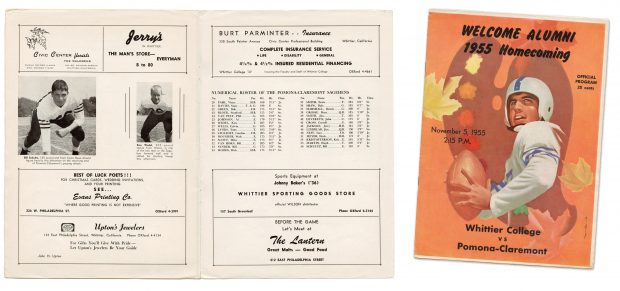Founded in 1922 by A.O. Woodford, a 1913 graduate of the College better known as Woody, the Geology Department has marked its centennial year. So did Woodford, a one-man department for 30 years who died in 1990 at the age of 100. A great-nephew of Pomona co-founder Rev. James Harwood, Woodford majored in chemistry before earning a Ph.D. studying soil science at UC Berkeley. In addition to his research, Woodford was known for developing scientists. Among them was Roger Revelle ’29, an early predictor of global warming. UC San Diego’s Revelle College bears his name.
Class Acts
Artifact: The Last Champs
The object below is a game program from the crucial contest of Pomona’s 1955 season, the most recent time the Sagehens were part of a SCIAC football championship season.
Pitzer College, Pomona’s current partner in athletics, had not yet been founded. Pomona and what was then Claremont Men’s College—now rivals as Pomona-Pitzer and Claremont-Mudd-Scripps—played together on a combined team known as Pomona-Claremont that claimed the third of three titles in a row.
The title-clinching win was a dramatic 14-13 victory over Whittier College in the Poets’ homecoming game, where this program sold for 20 cents. The two met late in the season as the only SCIAC teams that remained undefeated in conference play.
The recently completed 2022 season marked a poignant milestone for Whittier. The college dropped its football program after 115 years, along with men’s lacrosse and men’s and women’s golf. The decision was primarily for financial reasons. Whittier had not won a game since the pandemic canceled the 2020 season, going 0-18 over the last two seasons.
Whittier’s coach in 1955 was George Allen, who went on to coach the Los Angeles Rams and Washington Redskins. Pomona-Claremont was coached by Earl “Fuzz” Merritt ’25, for whom Pomona-Pitzer’s home field is named.
The Pomona-Claremont roster included end Bill Schultz ’56, tackle Ken Wedel ’56, halfback Herb Meyer ’57, guard/tackle Hugh Martin ’57, and halfback/quarterback Jim Lindblad ’58, all later inducted into the Pomona-Pitzer Athletics Hall of Fame. The name of a certain 165-pound sophomore end might also ring a bell.
Pomona-Claremont’s final game of the 1955 season was a 29-13 victory over rival Occidental in front of 6,000 fans in Claremont. Oxy’s standouts included quarterback Jack Kemp, who went on to play professional football and serve nine terms as a U.S. congressman. In 2020, Occidental announced it would discontinue its football program, ending the rivalry. Six remaining teams will compete for the 2023 SCIAC football title: Cal Lutheran, Chapman, CMS, La Verne, Pomona-Pitzer and Redlands.
Scholars and Fellows
Each year, Pomona graduates and undergraduates are awarded prestigious scholarships and fellowships for study in various places around the world. Downing Scholars and Gates Cambridge Scholars head to the University of Cambridge in England for graduate work. Fulbright Scholars and Watson Fellows travel to an array of international locations. Rangel Fellows train for careers in the U.S. Foreign Service. Knight-Hennessy Scholars pursue graduate studies at Stanford University. Goldwater Scholarships are awarded to undergraduates studying sciences, mathematics and engineering. Beckman Scholars earn mentored undergraduate research experiences in chemistry, biological sciences and related areas.
Beckman Scholars
Louie Kulber ‘23
Daniela Pierro ‘23
Downing Scholars
Kate Aris ’22
Jacinta Chen ’21
Calla Li ’22
Paul McKinley ’22
Fulbright Scholars
Kristine Chow ’22
Kelly Ho ’22
Brady Huang ’22
Steven Osorio ’22
Sayde Perry ’22
Nathan Shankar ’22
Ruby Simon ’22
Gates Cambridge Scholar
Sofia Dartnell ’22
Goldwater Scholars
Hannah Caris ’23
Jonathan Elisabeth ’23
Knight-Hennessy Scholar
Isaac Cui ’20
Rangel Fellow
Salamata Bah ’20
Watson Fellows
Xiao Jiang ’22
Mark Diaz ’22
2022 Wig Awards
Close relationships with professors are one of the special qualities of a Pomona College education. Each year, juniors and seniors vote for the Wig Awards, the highest honor bestowed on Pomona faculty, in recognition of exceptional teaching, concern for students and service to the College and community. This year, as in-person learning returned after more than a year of Zoom, seven professors were selected and confirmed by a committee of trustees, faculty and students.
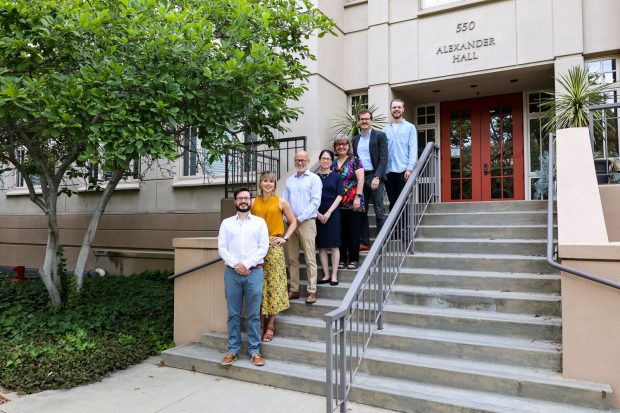
2022 Wig Award recipients, from left; Assistant Professor of Media Studies Ryan Engley, Associate Professor of Politics Amanda Hollis-Brusky, H. Russell Smith Professor of International Relations and Professor of Politics Pierre Englebert, Professor of Computer Science Tzu-Yi Chen, Willard George Halstead Zoology Professor of Biology Nina Karnovsky, Assistant Professor of Economics Malte Dold and Associate Professor of English Jordan Kirk
Prof. Jorge Moreno Leads Research Into Galaxies Lacking Dark Matter
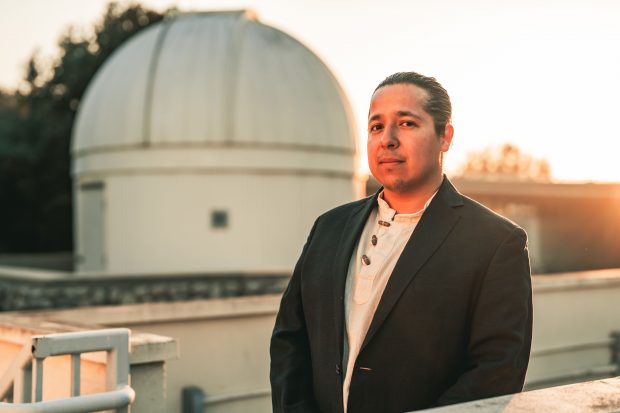
The discovery of galaxies with little or no dark matter is perplexing to scientists and challenges existing notions of how galaxies form. In a paper published in Nature Astronomy in February, a team of researchers led by Jorge Moreno, assistant professor of physics and astronomy, shared evidence they have found that may explain this baffling observation. Scientific American featured Moreno in a podcast about the work in April.
“For 40 years, astrophysicists have believed that all galaxies have dark matter,” Moreno explains in a campus interview.
That hypothesis was challenged in 2018, when Shany Danieli at Princeton University, who is the second author of the new paper, and Pieter van Dokkum of Yale published their finding of a galaxy in the real universe that lacked dark matter. A second such galaxy was reported in 2019. Astronomers use the term “real universe” to differentiate between what is seen in physical observation and what is found through computer simulation.
“Their discovery posed a huge challenge to the dark matter model of galaxies,” Moreno continues. “Many astrophysicists were suggesting that maybe we need to get rid of the idea of dark matter. Maybe we even need to modify the laws of gravity.”
Moreno took a sabbatical leave in 2020-21 to dig deeper into the challenge posed by these galaxies that lacked dark matter. He drew on his expertise in creating galaxy simulations and using supercomputers to model galaxy formation. Joining in the worldwide effort were astrophysicists from Princeton, UC Irvine, Caltech, the University of Zurich and other institutions.
The simulation modeled evolution over billions of years in a swath of the universe that was 60 million light years across. In it, the researchers identified seven galaxies lacking dark matter.
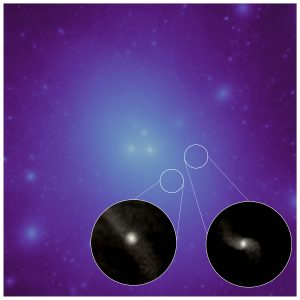
Researchers employed a cosmological simulation (FIREbox) to re-create numerical analogues (and explain the existence) of the two observed dark-matter deficient galaxies.
Researchers employed a cosmological simulation (FIREbox) to re-create numerical analogues (and explain the existence) of the two observed dark-matter deficient galaxies.
“What we found is that these galaxies initially had a lot of dark matter, and they had a lot of gas,” says Moreno. “But they fell into bigger systems. What we discover is that to become a galaxy without dark matter, it must interact with a galaxy that is a thousand times bigger than it is.”
Moreno drew on his identification with Indigenous peoples to name the galaxies found in the simulation. With the help of Doug Ingram, a Cherokee who teaches in physics and astronomy at Texas Christian University, Moreno obtained the permission of Cherokee leaders to give the galaxies the names of seven Cherokee clans: Bird, Blue, Deer, Long Hair, Paint, Wild Potato and Wolf.
“I’ve identified with these galaxies,” Moreno says. “These galaxies are not supposed to exist. They were supposed to be destroyed as they battled with massive galaxies, but they survived.”
Moreno finds a parallel in his Indigenous ancestry. Growing up in Mexico and the United States with a blossoming interest in mathematics, he didn’t see many scientists of color with whom he could identify, and navigating the power structures of academia was often challenging.
Sometimes Moreno felt excluded, and more than once he was mistaken for a janitor rather than a physicist. But, he says, “I had many mentors who believed in me. Sometimes they were warm, and sometimes they were harsh. But both were helpful in my growth to be the best version of myself, not to give up.”
As a theoretical astrophysicist and professor, Moreno honors his roots by investing in the success of the next generation of scientists of color. “I don’t want them to learn science,” Moreno says. “I want them to become scientists.”
While Moreno challenges all of his students to grow academically, he is invested in helping them find more than answers to questions in physics. He aims to help them discover, as he has, their place in the world of science. “For me, the scientific endeavor has been one of the most joyful things,” he says. “The message I want to send to my students is one of hope: ‘You belong.’”
How To Become a Scientific Illustrator
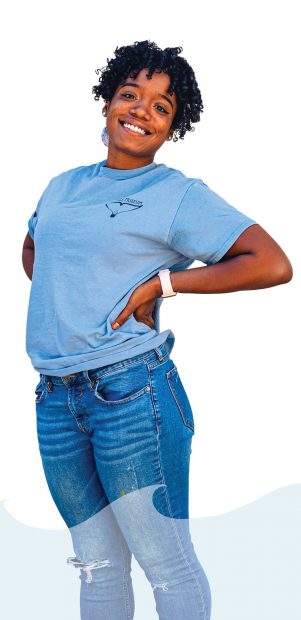 A May graduate with a degree in biology—and one of Pomona’s Commencement speakers as senior class president—Andreah Pierre ’22 has been interested in marine science and conservation for as long as she can remember. After earning a Posse Foundation scholarship followed by a prestigious summer fellowship, she will combine her STEM background with a rediscovered love of art to pursue a career as a scientific illustrator.
A May graduate with a degree in biology—and one of Pomona’s Commencement speakers as senior class president—Andreah Pierre ’22 has been interested in marine science and conservation for as long as she can remember. After earning a Posse Foundation scholarship followed by a prestigious summer fellowship, she will combine her STEM background with a rediscovered love of art to pursue a career as a scientific illustrator.
- Make your entrance near the ocean. Born in Miami, Pierre had an early affinity for the nearby Atlantic. “The best part was swimming with my sister,” she remembers. “Fish would pass by us, and we were like, ‘What are they?’”
- Stay curious. Nurture an interest in coral reefs, sea turtles and the effects of pollution as a student at South Broward High School, a marine science magnet school in Hollywood, Florida.
- Take an Advanced Placement art class and learn to paint. “The funny thing is, after sophomore year I never picked up another paint brush,” Pierre says. “My whole life was very much, you’ve got to do science, you’ve got to get a good job, and art did not seem like an option to me in terms of getting a good job.”
- Find your posse. Learn about the Posse Foundation, a program that selects talented students from the same city to attend an elite out-of-state college together on full-tuition scholarships, acting as each other’s support systems. Earn a Miami STEM Posse scholarship to Pomona, where biology students go whale watching on the Pacific.
- Apply for the prestigious Doris Duke Conservation Scholars program at the University of Washington, which provides two summers of experiential learning in the Pacific Northwest. For your second-year summer internship, join The Whale Museum staff in Washington’s San Juan Islands.
- Tasked with entering data on whale sightings reported to the museum, follow a mentor’s suggestion to develop an illustrated field guide to whales and other marine mammals to help the public tell a gray whale from a humpback. In the process, rediscover your love of art.
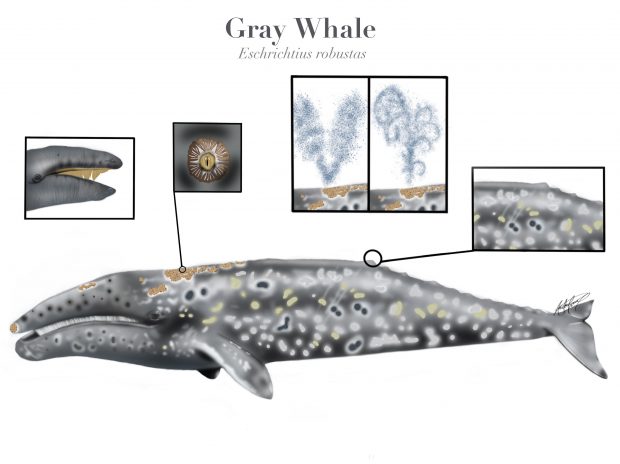
- Download a $10 app. After starting with a free paintbrush program, discover more sophisticated computer graphic tools that help you produce detailed images pointing out key features such as fins, flukes and surface behaviors. “What makes my field guide different from any other book you grab about whales is that the book will tell you all about the whale, versus my image is literally meant to only point out the things that you’d see if you were on the water,” Pierre says.
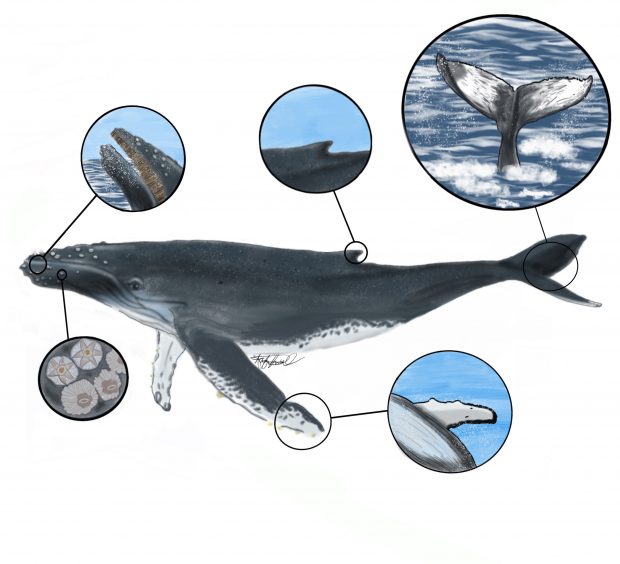
- Turn your summer project into your senior thesis, testing whether your field guides help people correctly identify types of whales and other marine mammals with the tips and images you provide. (The answer is yes.)
- Learn about Cal State Monterey Bay’s post-baccalaureate program in scientific illustration. Apply and get accepted for a one-year graduate certificate that starts in September, with courses such as botanical illustration, zoological illustration and professional practices for science illustrators, followed by a 10-week internship.
- Stop to watch the elephant seals at Año Nuevo State Park on a trip along the California coast and realize that state and national park signage needs science illustrations too. “A lot of them are old, the paint’s chipped and there is new information from the last 10 or 20 years that should be on there,” Pierre says. Build your portfolio as you look to follow other graduates of the Monterey Bay program, whose work can be found in such places as the Smithsonian Institution, the American Museum of Natural History, National Geographic and Scientific American magazines, and at zoos, aquariums and botanical gardens across the country.
A Namesake Fossil for Geology Prof. Robert Gaines
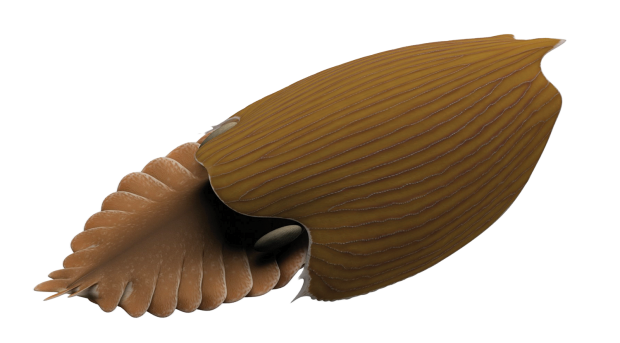
After years of uncovering fossils and discovering species from millions of years ago, Pomona College Dean and Geology Professor Robert Gaines now has one named after him.
It’s a doozy.
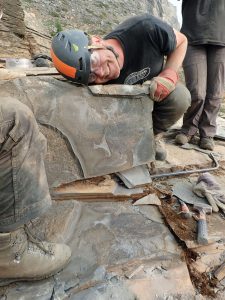 An ancestor of arthropods such as crustaceans and insects, the long-extinct animal’s name is Titanokorys gainesi, meaning “Gaines’s titanic helmet.” It lived during the Cambrian Period about 500 million years ago, when animal life was brand new and had not yet crawled out of Earth’s oceans and onto land.
An ancestor of arthropods such as crustaceans and insects, the long-extinct animal’s name is Titanokorys gainesi, meaning “Gaines’s titanic helmet.” It lived during the Cambrian Period about 500 million years ago, when animal life was brand new and had not yet crawled out of Earth’s oceans and onto land.
Described as one of the largest animals of its time, Titanokorys gainesi was about two feet long with large, multifaceted compound eyes, a pineapple-slice shaped mouth, a pair of spiny claws at the front of the head to capture prey, and a body with a series of flaps for swimming.
“It feels tremendous to be honored in this way with a fossil that is so special in terms of its size and its ecology,” Gaines says. “As a child, I noticed that many fossils are named after people and I often marveled at the contributions that those individuals made to science. I think this is really moving and I feel so fortunate to be a part of this project.”
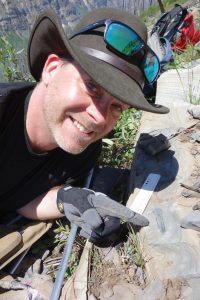 The newly discovered species comes from the Burgess Shale, a rock formation found high in the Canadian Rockies that preserves fossils of soft-bodied creatures, such as jellyfish and worms that decompose rapidly and don’t normally fossilize. It was discovered more than a century ago and became a watershed for understanding the origins of complex life on Earth. Gaines and a small team of researchers began working there in 2008, with the support of Parks Canada.
The newly discovered species comes from the Burgess Shale, a rock formation found high in the Canadian Rockies that preserves fossils of soft-bodied creatures, such as jellyfish and worms that decompose rapidly and don’t normally fossilize. It was discovered more than a century ago and became a watershed for understanding the origins of complex life on Earth. Gaines and a small team of researchers began working there in 2008, with the support of Parks Canada.
In pursuit of new discoveries, Gaines and the team began exploring outside the original discovery site and eventually settled about 30 miles southeast in Marble Canyon in 2012.
“We were not expecting to find what we had found in 2012. We were actually expecting to see strata that were very different, but the maps that had been made a generation ago were incomplete, and so the geology was confusing. Then, all of a sudden, like ‘boom,’ things snapped into place and we started to find new fossil forms hand over fist,” Gaines adds.
Gaines says the team began to find fossils of organisms that were completely new to science. With subsequent years of work and exploration in the region, that list of dozens of new species would grow to include what would become known as Titanokorys gainesi, discovered in 2018 during an excavation that included three geology students from The Claremont Colleges. These fossils can help scientists answer many questions about the origins of animals and the fundamental structure of the animal family tree.
“The questions are about the origin of complex life on the planet,” Gaines says. “The interesting thing about the era that we work on is that the origin of animals didn’t happen slowly or gradually as Darwin would have predicted, but instead our fossil record is really clear that there’s sparks of diversification that happened incredibly rapidly, almost instantaneously from a geologic point of view.”
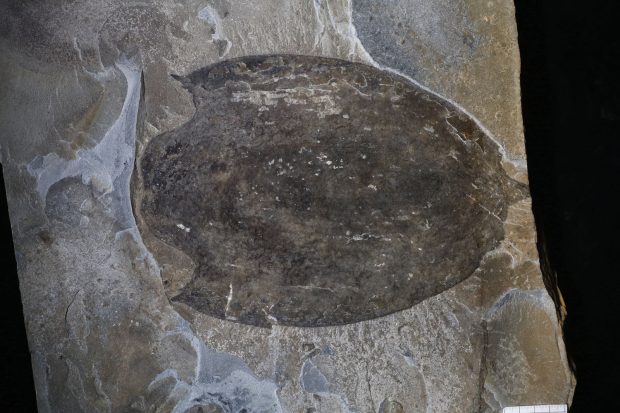
Gaines also works on similar fossil deposits around the world, including in China, where he was part of a team that announced a major discovery of new fossils in 2019.
Gaines hopes to continue his research in Canada in the summer of 2022.
How to Become Pomona’s CIO
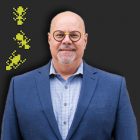
Chief Information Officer is a C-suite job that didn’t exist until the 1980s, when the term was coined by business experts in recognition of the extraordinary growth of the role of computer technology. That means there wasn’t much of an established career path until more recently—and José C. Rodriguez, Pomona’s new vice president and CIO, took the scenic route in a journey that embraces the liberal arts.
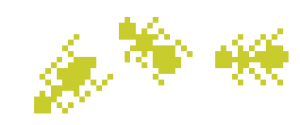
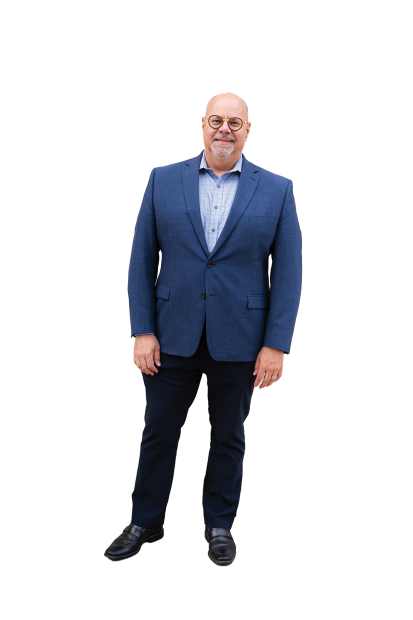 1. Grow up in New York City and develop an unexpected appreciation of bugs—and not the computer programming type. “Even as a child, I just loved being outside. I loved turning over rocks,” says Rodriguez, who has a deep affection not only for insects but also for animals and the outdoors.
1. Grow up in New York City and develop an unexpected appreciation of bugs—and not the computer programming type. “Even as a child, I just loved being outside. I loved turning over rocks,” says Rodriguez, who has a deep affection not only for insects but also for animals and the outdoors.
2. Earn a bachelor’s degree in entomology from the University of Georgia and move cross-country for a master’s at Washington State. Get to know Western bugs like the bombardier beetle, which shoots a noxious spray from its lower abdomen when disturbed.
3. Take a job in a molecular biology lab at Emory University, working on mosquito transmission of malaria. Encouraged by a principal investigator with large amounts of data to analyze, take courses in database management and data programming. Launch your new tech career as an IT support specialist and manager at the university.
4. Learn Arabic on the side during a 10-year role as director of technology for Emory’s new language center as it transforms traditional teaching methods with a multimedia approach. Travel to Italy with a professor to film cultural scenes, art and architecture for new digital learning content.
5. Move to Emory’s Candler School of Theology and become a very early adopter of Zoom, around 2015. Introduce streaming weekly chapel services and co-develop an online program that lets pastors work toward doctor of ministry degrees while still serving their congregations.
6. Begin to see technology with new eyes. “I really started to think more broadly about what an institution does and what it needs from technology, not just support of technology,” Rodriguez says.
7. Move to Memphis in 2018 to become CIO at Rhodes College, joining an institution’s top leadership group for the first time. Help shape the pandemic response and lead the pivot to online learning.
8. Continue to embrace online communication for its less obvious benefits. “We take in-person for granted. There’s a group of society that can’t be in person or doesn’t function easily that way,” Rodriguez says. “I think it’s important to remind ourselves that this is about accessibility as well as about an emergency response.”
9. Join Pomona and the 7CIOs, a rare community of campus technology leaders with opportunities to innovate together. “I would love to just express how happy I am to be here as part of the Pomona and Claremont Colleges community and I want to do everything in my power to improve on the teaching and learning of the schools. I’m very approachable. If people want to reach out, I am available to chat.”
10. Back to the bugs. There’s one insect common in the South that Rodriguez won’t miss. “Mosquitoes,” he says. “Someone was telling me you won’t have a lot of mosquitoes in California. I said, ‘Well that is fine with me.’”

New Registrar
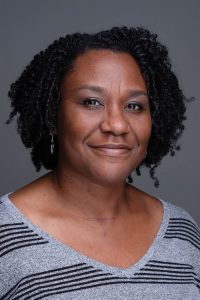
Erin Michelle Collins
The College’s new registrar, Erin Michelle Collins, started in July and comes to Pomona after serving in the same role at California Institute of the Arts. Prior to CalArts, Collins worked in positions of increasing responsibility within admissions and records at the University of La Verne, Victor Valley College and Barstow Community College.
Collins holds a bachelor’s degree in social psychology from Park University in Missouri and a master’s in psychology from The Chicago School of Professional Psychology. She arrives at Pomona a century after Charles Tabor Fitts became Pomona’s first full-time registrar in 1921, at a time when enrollment was just over 700 students and The Claremont Colleges consortium was yet to exist.
Today, Collins says, registrars’ work reaches beyond student and academic records management to include running student information systems and providing data that drives policy and improves student success. Most importantly, “a registrar has to be service-oriented, as retention and student success is directly related to how connected a student feels to their institution,” says Collins, “As the registrar, I can directly impact this connection.”
Wig Awards
Every year, juniors and seniors nominate professors for the Wig Awards, Pomona College’s highest honor for excellence in teaching, concern for students, and service to the College and community. During an extraordinary year of remote instruction due to the COVID-19 pandemic, six faculty members were elected by juniors and seniors and confirmed by a committee of trustees, faculty and students.
The 2021 recipients are:
- Eleanor Birrell,
assistant professor of computer science - Erica Dobbs,
assistant professor of politics - Phyllis Jackson,
associate professor of art history - Joanne Nucho,
assistant professor of anthropology - Kara Wittman,
assistant professor of English - Yuqing Melanie Wu,
professor of computer science
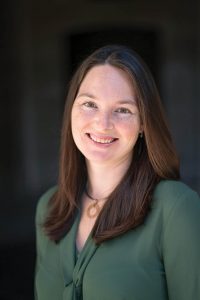
Eleanor Birrell
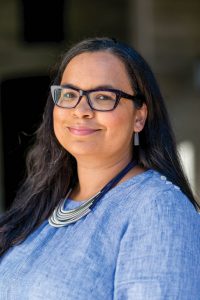
Erica Dobbs
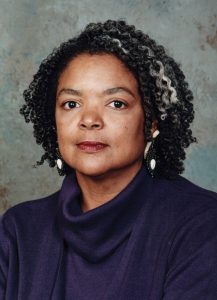
Phyllis Jackson

Joanne Nucho
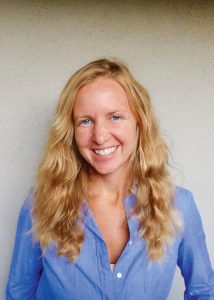
Kara Wittman
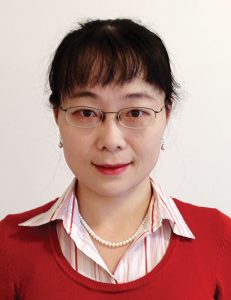
Yuqing Melanie Wu
Each of this year’s recipients is a first-time winner, except for Jackson, who was previously honored in 2003, 2010 and 2015.
